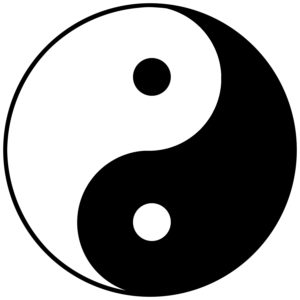 While strategic planning offers up the opportunity to generate new ideas, confirm or refocus direction, and gain momentum, the road from here to an agreed upon set of strategies usually involves tough decisions.
While strategic planning offers up the opportunity to generate new ideas, confirm or refocus direction, and gain momentum, the road from here to an agreed upon set of strategies usually involves tough decisions.
At the heart of our strategic expeditions, divergent needs and competing demands are encountered. The biggest challenge is that even with extensive preparation, research, data and discussion; there isn’t always a “best” path forward. Without clear ‘right’ answers, frustration, compromise, and the possibility of getting lost become high-stake risks.
Being regularly challenged to help my clients work through strategic dilemmas, I started to think more about the ancient Chinese concept of Yin and Yang. Attracted to the concept in the area of life balance, I set out to see how the philosophy might be beneficial to business planning.
Looking through a Yin and Yang lens at tough business decisions can offer new ways to think about a complex situation.

The familiar Yin and Yang symbol depicts two ideas that are very much interrelated and connected. There is a part of Yin in Yang (the dot) and vice versa. The two forces interact and must be balanced. The forces are both opposite and dependent on each other.
So how does Yin and Yang help us with strategic planning? Let’s look at a common business dilemma.
Competing demands between the internal needs (organization, employees) of a business and the external needs (stockholders/investors, customers, society) are a typical challenge for those in business. Solutions and planning discussions are often based on applying resources to either one or the other initiative. We tend to view the needs as separate and apart, when in reality they may be very much related. There is no right strategy to satisfy stockholders without taking into account the needs of the employees. The two are interdependent and the needs of both must be balanced and continually managed. Yin and Yang do not exclude each other. They are mutually dependent. The solution to the dilemma involves a solution that includes both.
In Built to Last authors James C. Collins and Jerry I. Porras discuss a block that leaders tend to get caught in called “The Tyranny of the Or”, the belief that you cannot live with two contradictory ideas at the same time. For example it is impossible to maintain low expenses and quality, nor maintain stability and foster change at the same time. This perspective is contrasted against “The Genius of the And”, the idea that you can and must have both at once, taking on two extremes at the same time instead of choosing between A and B.
“A visionary company doesn’t simply balance between idealism and profitability: it seeks to be highly idealistic and highly profitable. A visionary company doesn’t simply balance between preserving a tightly held core ideology and stimulating vigorous change and movement; it does both to an extreme. In short, a visionary company doesn’t want to blend yin and yang into a grey, indistinguishable circle that is neither highly yin nor highly yang; it aims to be distinctly yin and distinctly yang – both at the same time, all the time.”
There are a number of excellent tools that are can be used to help with strategic planning that speak directly to the concept of ‘interrelated but competing demands’. Two that are worth mentioning here are The Balanced Scorecard and SWOT
The Balanced Scorecard designed by Robert Kaplan and David Norton offers large and small businesses alike the opportunity to measure performance on a set of related but competing goals. Learning and development, system and process and customer goals are just as important as financial goals to achieve desired results. The tool is used to keep these competing but complementary initiatives in the forefront, especially as real world challenges enter the picture.
SWOT an organizational assessment tool is designed to help leverage organizational strengths and opportunities while identifying limitations and potential marketplace threats or risks. The model offers a framework that helps identify new forward-thinking ideas by looking from opposite perspectives combined in new ways.
Another term we use for two opposing ideas is a paradox. With a paradox there is a dilemma and tension. Instead of viewing the tension negatively, try thinking about it as both healthy and beneficial. The possible interdependencies may provide richer thinking and stronger solutions when the focus becomes not choosing one or the other, but how to achieve a dynamic balance between the two. The challenge is to get comfortable with contradictions and be able to hold both truths at once. Most of us have a hard time with shades of gray. The more we become comfortable with paradoxes when we feel the tension, the less we may get stopped or blocked. By learning to accept two conflicting ideas it frees us up to move forward.
As a trained strategic planning facilitator my primary role is to help teams generate divergent thinking (generating alternatives, open discussion, gathering diverse points of view), then bringing those ideas together into convergent thinking (evaluating alternatives, summarizing key points, sorting ideas into categories, arriving at inclusive solutions). The process involves looking at interrelated competing demands and coming up with solutions that take into account a variety of perspective.
Here are a few common strategic choices that center on competing ideas:
- Working in the business (client demands) or on it (strategy, innovation)
- Struggles between top down management and bottom up participation
- Short term results or long term growth opportunities
- Stability (current state of affairs) or investing in the future
- Slowing down or getting there faster
- Chaos and order
Regarding the last point, Margaret Wheatley in one of my all-time favorite leadership book, Leadership and the New Science suggests that we are coming to a new definition of order. “Control is not order.” “Flexibility, superior results and customer satisfaction are the watchwords in an environment of ever changing demands and requirements- Unpredictability, Inconsistency, Chaos.”
“No single person or school of thought has the answer, because what’s required is far beyond isolated answers. We can realize that we must inquire together to find the new. We can turn to one another as our best hope for inventing and discovering the worlds we are seeking.”
What strategic choices have you been wrestling with that can benefit from a yin yang point of view?
Learn more about Business Coaching with Helene Mazur
Written by Helene Mazur
Helene is the founder of Princeton Performance Dynamics, an executive coaching and strategic planning facilitation company for business and non-profit leaders and their teams. Helene’s passion is helping her clients to focus their goals, see new perspectives on their current situation, put in place realistic, motivating plans, and execute to achieve new levels of success.
Permission to Reprint: Helene Mazur’s articles below may be reprinted hard-copy or electronically in your publications provided that the short bio at the end of each article is included and a copy of the hard-copy or electronic publication is forwarded to Princeton Performance Dynamics, 81 Bertrand Drive, Princeton, New Jersey 08540. Permission given for reasonable editing for space constraints and publication format. For articles electronically published, a live click-able hyperlink to www.ppdbusinesscoaching.com is also required. If the above parameters are not met, a payment of $300 per article, per usage, is expected. Send your check to Princeton Performance Dynamic at the above address.
